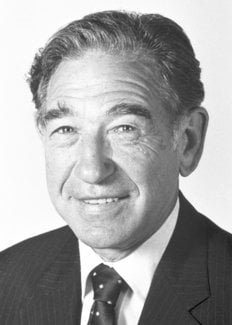Stanley Cohen
Biographical

I was born in Brooklyn in 1922. Both my mother and father were Russian Jewish emigrants who came to America in the early 1900’s. My father was a tailor and my mother, a housewife. Though of limited education themselves, they instilled in me the values of intellectual achievement and the use of whatever talents I possessed.
I was educated in the public school system of New York City and was bright enough to be accepted at Brooklyn College. Fortunately for me, my college education was most thorough (I majored in both Biology and Chemistry). Perhaps equally important was the fact that Brooklyn College was a city school and had a policy of no tuition; the cost of an education would have been prohibitive for my parents.
My scientific interests throughout my undergraduate days were directed to cell biology and especially the mysteries of embryonic development. I think my one insight into these problems was the recognition that much could be learned by the application of chemistry to biology.
After working for a short period as a bacteriologist in a milk processing plant to save enough money to go to graduate school, fellowships enabled me to continue my education, first at Oberlin College, where I received an M.A. in Zoology in 1945, and then in the Biochemistry Department at the University of Michigan where I received a Ph.D. in 1948. My Ph.D. thesis concerned the metabolic mechanism by which the end product of nitrogen metabolism in the earthworm is switched from ammonia to urea during starvation. I remember spending my nights collecting over 5,000 worms from the University campus green.
I believe it was my ability to stomach-tube earthworms that convinced Dr. Harry Gordon to offer me my first job in the Pediatrics and Biochemistry Departments of the University of Colorado, where I was involved in metabolic studies of premature infants.
Feeling the need to gain experience with the then emerging application of radioisotope methodology to biological research, I left Colorado and went to Washington University in 1952 to work with Martin Kamen in the Department of Radiology at Washington University as a postdoctoral fellow of the American Cancer Society. I learned isotope methodology while studying carbon dioxide fixation in frog eggs and embryos, and also derived a priceless education participating in the journal club administered by Dr. Arthur Kornberg who had just arrived at Washington University.
In 1953 I became associated with the Department of Zoology under the leadership of Viktor Hamburger at Washington University with a two-fold purpose in mind. I joined with Rita Levi-Montalcini to isolate a Nerve Growth Factor (NGF) that Dr. Levi-Montalcini had discovered in certain mouse tumors and to become educated in the field of experimental embryology. I leave it to Dr. Levi-Montalcini, with whom I am honored to share this Nobel Award, to recount the results of our early collaboration.
I came to Vanderbilt University in 1959 as an Assistant Professor in the Biochemistry Department where I have been ever since, exploring the chemistry and biology of epidermal growth factor (EGF) that is the subject of this lecture.
In 1976 I was appointed an American Cancer Society Research Professor and in 1986 Distinguished Professor. The works recognized by this Nobel Prize are clearly a group effort of achievement as may be seen from the names associated with our publications on EGF. They share in this honor. I have received much recognition during my research career and I am most grateful.
| Honors |
| Research Career Development Award, National Institutes of Health (1959-1969). |
| National Paraplegia Foundation’s Second Annual William Thomson Wakeman Award (1974). |
| American Cancer Society Research Professor of Biochemistry (1976). |
| Earl Sutherland Prize for Achievement in Research, Vanderbilt University (1977). |
| Albion O. Bernstein, M.D. Award (Medical Society of the State of New York) (1978). |
| National Academy of Science (1980). |
| H.P. Robertson Memorial Award, National Academy of Science (1981). |
| Lewis S. Rosenstiel Award, Brandeis University(1982). |
| General Motors Cancer Research Foundation, Alfred P. Sloan Award (1982). |
| Louisa Gross Horwitz Prize, Columbia University (1983). |
| Distinguished Achievement Award of the UCLA Laboratory of Biomedical and Environmental Sciences (1983). |
| Lila Gruber Memorial Cancer Research Award, American Academy of Dermatology (1983). |
| Bertner Award of M.D. Anderson Hospital, University of Texas (1983). |
| American Academy of Arts and Sciences (1984). |
| Charles B. Smith Visiting Research Professorship, Sloan Kettering (1984). |
| Honorary Doctor of Science, University of Chicago (1985). |
| Gairdner Foundation International Award (1985). |
| Feodor Lynen Lecturer, University of Miami 18th Miami Winter Symposium (1986). |
| National Medal of Science (1986). |
| Steenbock Lecturer, University of Wisconsin (1986). |
| Fred Conrad Koch Award, The Endocrine Society (1986). |
| Albert Lasker Basic Medical Research Award, Albert and Mary Lasker Foundation (1986). |
| Nobel Prize in Physiology or Medicine (1986). |
This autobiography/biography was written at the time of the award and later published in the book series Les Prix Nobel/ Nobel Lectures/The Nobel Prizes. The information is sometimes updated with an addendum submitted by the Laureate.
Stanley Cohen died on 5 February 2020.
Nobel Prizes and laureates
See them all presented here.
